American Sabbatical 017: 9/18/96
Corn Palace
9/18... Iowa continued.
I proposed we make some big jumps before Iowa got us, like Illinois did. So we closed our eyes
to all temptations and booked it from the Amanas to Ames. College
town. Ought to have a veggy restaurant, right? Not on your beefeating
life. We scoffed up some strange vegetable pastries in a “Brazilian”
bistro, under posters of Rio, with guitars strumming in the background,
and the waiter (who had mastered his manana) looked amused that
all we wanted was appetizers. We backpedaled quietly past the
huge sports stadia and Colosseum, lest we get captured and fed
to the lions..or bears..or whatever the STATE animal is there.
I’d found a campground mentioned in a mag in the bistro, and after
some redirected calls we were pointed toward an Episcopal Conference
Center and Campground in Boone, Iowa...home of Mamie Dowd Eisenhower...
in the dark, down dirt roads, out beyond the city lights. Was
it possible? A campsite with no trains or highways. What about
ambiance? Would the RVs get restless? We groped in at last, were
greeted warmly by the garrulous older (us over-50s choose adjectives
more carefully) volunteer, who warned us that the most annoying
amenity of the place was the noisy wild turkeys, and scootched
into our wickiup. Nary a train toot. But the anomaly was explained
in the AM. We woke up to find ourselves camped in a field of big
yellow cabooses, which doubled as special accommodations. Imagine
our relief.
9/19.. To South Dakota.
Starting out next morning we made up for our trainless night by encountering a mile-log,
four-engined, double-piggybacked container train running west
through Boone, and we Festivaed alongside it for the next hour.
Those babies run at 65mph blowing A to the bar. The productive
power, the agricultural wealth, the thundering wheels, the great
get up and go of America, stands naked out here like the muscles
on a dancer. Small wonder Kennedy brought Khrushchev to Iowa to
show him our invincibility. Blowing along in the semis’ wake with
the long freights keeping time, even the Red Festiva feels like
bragging a little.

Iowa is a state worth bragging in. Its crisscrossed quilted croplands, the rolling swells and bending rivers, brown and green corn, yellow beans, brilliant white grasses (Miscanthus robustus), the modest, tidy farms, the unassuming cozy towns.. this is the Heart of America (and it’s almost as lily-white as Maine). Where Illinois looked dead or overworked, Iowa seems healthy and alive. We didn’t see a single dead town here, and the pattern of agricultural management (from the road, at least) seemed less absentee than elsewhere. The farmsteads were frequent and frequented. The towns bustling. And the big rigs of midnight roll on.
One of our zigs took us into the Twilight Zone again. Peggy’s
grandmother Rosten was an Ida, so we had to check out “Ida Grove.”
Little did we know. Suddenly we were face to facade with a moorish
castle, towers, battlements, the whole megilla. Then draw bridges,
industrial buildings like haciendas. A city gate out of Toledo.
Holy Toledo.
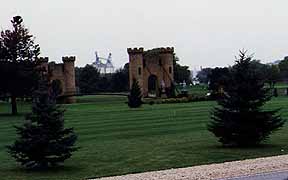
Ida Grove
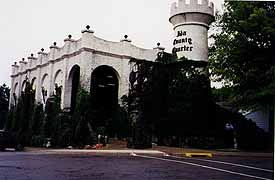
Old News
Had some enlightened industrialist created a playground for his
employees, a company theme town? With three-masted pirate ship
in a little lake? With a Pizza-Hut on pilings? Or was this a town
with weird zoning ordinances? We drove into Ida Grove. The newspaper
office was in a heavily stuccoed, wrought-ironed, and crenelated,
fortification/ranchero in the heart of town. They smiled at my
questions.
Yes, indeed HE (they never did give me a name) had started Midwest Industries, and His boat trailers were so successful that He’d made a fortune. And built a fantasy town to suit His imagination. Now retired and living in Minnesota and Florida, He still visited occasionally to see that Ida Grove keep up its reputation. He also was fascinated by model airplanes, which explained the other local business, the model plane fuel manufactory. Clear prop. We swung our propeller and taxied out of Ida Grove.
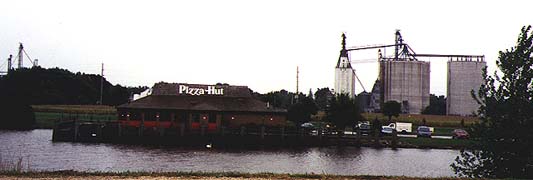
Pirate Pizza
We rolled off the highroad into Sioux City in a raging downpour. Even the rainmakers were smiling on us. We wanted to make some miles, and they were hiding the distractions from us, cooling our eyes. All that water made us think about laundry, and we ended up in the Vietnamese section of Sioux City. Ain’t America Grand? We watched, what else, soap operas.. with subtitles(in English).. and did our book-keeping while our unmentionables got mentionable.
We wanted to see the mighty Missouri, and the map said it was
right there, but it’s hard to find the rivers in this asphalted
land, and we were whisked back onto a flyby and dumped out in
South Dakota before you could say Lewis and Clark. Did they take
I-29 over the Big Sioux?
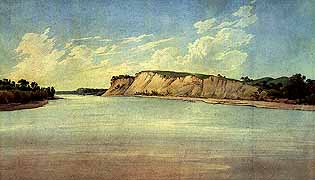
Missouri at Sioux City 1833 (Bodmer)
Finally the munchies and the translucent air drove us into Elk Point, South Dakota, and we sprinted into Cody’s steak house. We didn’t ask for the quiche menu. Bunch of the boys were lined up along the counter jawing about it being too deep to plow but not deep enough to fish in. We asked about rain in South Dakota, and they told us that it only rained two ways here: too soon and too late...and too much, one added. We agreed, and came to a soggy stop in Yankton at the Super8. Modem jack and all.
9/20... True West.
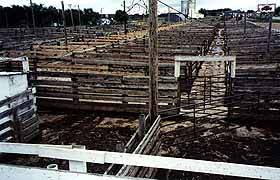
Headem up
Last night I left you on the brink of the 100th meridian, and the east bank of the big muddy in
Yankton, South Dakota. We had blown out of Iowa with a wet Easterly
at our back. And a wet wind was just as well, considering all
the feedlot operations we passed in western Iowa. As the swells
stretched out, the smells got thicker. The intensive agriculture
thinned some more, and there was more beef on the hoof. The roadside
vegetation had gone from abundant explosions of head-high yellow
daisy-like flowers, and chicory in Illinois, to profusions of
white and beige ornamental (to us) grasses as we approached the
West. We were passing from Midwest prairie to plains rangeland.
Architectural notes: I haven’t reported the succession of barn
shapes and styles for a while, but I’ll try and recapitulate.
Moving south in Illinois the eve slopes came farther down to the
ground into the familiar hill-billy image of drooping house and
barn roof. The unbroken roof line from peak to eave shifted from
a higher angle to more gradual slope, as we drove from north to
south, as you’d expect where snowloads lessen. From east to west
the percentage of “Dutch” barns increased, until an unbroken-sloped
roof was a rarity. Barn cupolas had been either circular tin vent
structures (especially in NY State), or relatively modest square,
peaked cupolas, east of the Mississippi. Across that water, cupolas
expanded until they overshadowed their barns. Dutch-roofed barns
with huge peak-roofed houses on top looked very strange to this
cupola connoisseur. Meanwhile the silos were changing. The sky-stabbing
silo of New England persists everywhere, and there are some glazed
block-and-mortar silos in the Midwest to die for. But the towering
silo of old has been totally outnumbered by the squat cylindrical
metal storage structures (also called “silos”) clustered together
in little villages of grain, with an elevated superstructure of
conveyor pipes connecting them to a central tower. These mark
the change from storage of cut corn-and-shock in a fermentorium
(silage) for feed, to storage of dried kernels for market. In
addition there was an occasional oval shaped (in cross-section)
silo, walled up in blocks with holes in the middle..like swisscheeze
buildings.. which I was told are for silage also. They are boarded
up when filled, but the boards removed for ventilation as the
silage goes down. Are you nodding off yet.
The barns of America are defining elements in our landscape, our Jeffersonian high churches, and their regional variety may tell us something about our agricultural faith. Or at least our heritage. Are the “Deutsch” barns of Iowa a trace of her Germanic settlers? Somewhere in Iowa there seems to be a differentiation of barn function. One barn becomes two barns. One, often with “eastern” roof, and then a “dutch” barn with megacupola. Is this grain storage and animal housing? And the grain elevators at the rail crossings get bigger and more prevalent. Crossing into South Dakota the old tower silos acquire a checkerboard band (mostly black and white) around the top of the cylinder, just below the cap. Then, across the Missouri, a second band appears about halfway up the silo. Is this a sacred Grange symbolism? A corporate commitment? The Purina effect? I simply report.
Grant Wood had great fun with such stuff. One of his lithographs,
called “Fertility” has a bold phallic silo (he modified the cap,
just so) standing next to a wide-hipped barn. He used the shadow
from the gable-end projection (which becomes frequent in Iowa)
to suggest..well, suggest. Have I been looking at too many barns,
too?
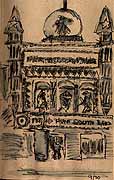
Bryce's Palace
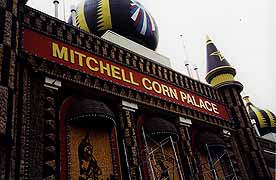
Corn Architecture
Before the barns so rudely interrupted, I was gathering the wagons
on the east bank of the Missouri in Yankton. A wide and soupy
thing there. But we turned north away from her on a lowery morning
with blowing rain, headed for Mitchell, and THE CORN PALACE. There
IS a capital of kitsch out here. In fact, I’m beginning to think
that Maine is too uptight to really take advantage of her instinct
for bad taste. We don’t cover a building with local scenes ten
feet high made out of clam and lobster shells, beach-glass and
dried seaweed. But we could. Then a honkytonk tourist junkorium
might grow up around it, like in Mitchell.
This also happened to be Corn Festival Week, and the streets were
full of carnival rides, knickknack peddlers and the usual suspects.
There’s nothing as dreary as a sideshow in the rain. Worn carnies
in leather jackets, with frayed-cuff jeans and dirty shoes, standing
around sucking on wet cigarettes and passing a flask. Hang onto
your wallets kids. I was chatting up a sunglasses peddler (how
we go back to our roots) when a gust of wind blew his whole display
all over the street, and we were drenched with a shower. After
I helped him re-rig his pitch, he gave me a pair of glasses (scratched,
of course), and we grinned knowingly at the humor of fate.
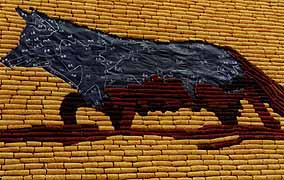
Corn By Numbers
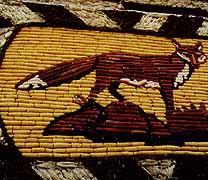
Fox in the Corn
There is the biggest cast-cement kitsch emporium I’ve ever seen
next to the CORN PALACE. Peggy wouldn’t let me get even a coiled
cement rattler to keep under the seat. Lucky we weren’t driving
a pickup. First we had to turn down the 6-foot tall fiberglass
gorilla we saw in Missouri, and now this. I mean ten-foot long
cement lions, and big boot planters. Imagine the Maine Bean-boot
planter. I mean, imagine.
Peggy managed to discover a gem of an archeological museum in Mitchell, goddess knows how...
(Memo #17)
Sept. 20 - Mitchell Prehistoric Site, Mitchell, S.D.
Who? pre-Columbian village people of Great Plains
What? archaeological site (70 earth lodges lodges in fortified
village on bluff)
Where? Mitchell, South Dakota
When? 1000 A.D.
How? agriculture + hunting
Topics: Native American adaptations, Plains environment, prehistoric
site
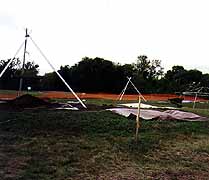
OnSite
Questions: What were the 2 types of Native Americans who inhabited
the Plains? Why do we know one group so much better than the other?
What might have happened if the river group of the west had survived
and become Hollywood icons?
When the white men started up the rivers of the Plains, especially the Missouri, they found two types of Native American tribes. One type of tribe was the nomadic hunter-gatherers who were so focused on the buffalo (Cheyenne, Sioux, Arapahoe and many others). These were the tribes that became the focus of Hollywood westerns, the tribes that attacked wagon trains and engaged in constant ritualized warfare. Our media image of Native Americans is very much that of the Plains nomads roaming the grasslands. This is strange for two reasons, first , there were so many other interesting and more numerous tribes, from whale hunters of the northwest to acorn grinders of California to the city living farmers who inhabited Cahokia(Memo #13). The other reason is that the Plains buffalo-hunters had a very new way of life ; these tribes used the grasslands in new ways as nomads thanks to the horse which the Spanish introduced to the New World. Before 1520, when Cortes led an expedition to Mexico City, horses were unknown in North America. After that, horses spread very fast and tribes quickly became horse oriented.
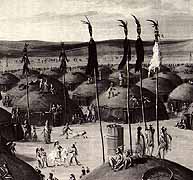
Mandan Village (Catlin)
So who were the other tribes with the older Plains adaptation?
This type of tribe lived in permanent villages along the rivers,
tribes like the Mandan, Arikara, and Hidatsa. They combined farming
with hunting and gathering. They lived in round earth covered
lodges ( which were vividly illustrated by artists like George
Catlin). These villagers living in permanent settlements were
much more susceptible to destruction by the white men’s diseases
and most of these groups were totally wiped out by the year 1900
a.d. They did not become film icons or tourist sites.
The Mitchell site is the remains of a farm village of about 1000 a.d. on a bluff by a river. Archaeologists are still digging the site. A superb small museum displays artifacts and explains the way of life. There is also a reconstructed earth lodge that you tour. The way of life becomes incredibly alive. They also keep a garden of plants true to the time.The museum is planning to construct a permanent building over part of the site (an archaeodome) so that visitors can see archaeologists at work and archaeologists can work year round. This will be the only museum of its kind in the world.
I toured the museum, saw the short film and then took the self
tour of the site. It was a cold drizzly day with no one about
and I could really feel the life of the ancient village. The Mitchell
village, they estimate, had 1000 people living in 70 rectangular
earth lodges (each about 20’X 40') spread over about 5-10 acres.
The village was surrounded by two types of fortifications, a manmade
ditch and a palisade of upright posts. The people used a wide
variety of stone, bone, and pottery implements found in storage
pits and trash sites. They hunted and fished a wide variety of
species and depended a great deal on the buffalo.
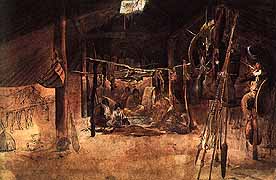
Inside a Mandan Lodge (Bodmer)
When I visited, site archaeologists had just found artifacts that proved contact with the groups in the Cahokia region.
9/20.. continued.
...THEN we pointed her WEST for the big muddy.
Eastern Iowa had a cozy half-sectional beauty to it, but South Dakota has a wilder grandeur, especially in the river volleys. It’s Iowa writ grand. The greens and yellows of cropland yield to all the siennas, beiges, and russets of autumn rangeland. Vast acreages of grains and sunflowers (now nodding brown at maturity) vary the scene, and the scattered black cattle, and solemn rolls of hay populate the nakedness. Different counties seem to stack their hay rolls differently, like regional emblems: long rows, high piles, curious architectures, or just as they lay.
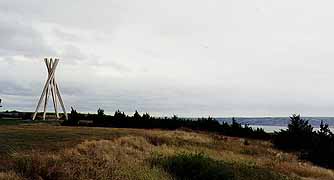
Highway Art at Chamberlin
As the land started to stretch out in eastern Iowa there was some
attempt at extending the crop acreage by dikeing the hillslopes,
which gave the scene a terraced effect. But in South Dakota the
hillsides are given up to the grasses. It starts to look like
Indian country, and you realize how the horse must have revolutionized
the plains culture. It was easy to imagine millions of buffalo
pouring over the hills and through the gullies.
We were bucking a Festiva-shoving headwind due west when we came
up on the Missouri at Chamberlain (right next to “Kennebec”),
obviously the right place for Mainers to cross.. hard by the 100th
meridian. A spectacular crossing, wild folded hills falling to
rocky bluffs, and a hard wind chopping up the sour gray-green
waters.
Then the land rises, rolls and rises, and opens out to infinity.
If you thought the Midwest was wide and flat, think again. Maybe
it’s the range beyond range of hills defining the immense distance,
or maybe the West IS bigger. You can feel your spirit stretching
to match the landscape. The sun kept trying to break through,
but bands of black rain streaked from the backlit stratocumulus,
painting stupendous inkwash skyscapes, until the descending sun
poured red down the western horizon and glared out in glory. We
pulled, dazzled, into Murdo. True West, at last.
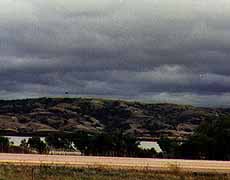
Ink wash